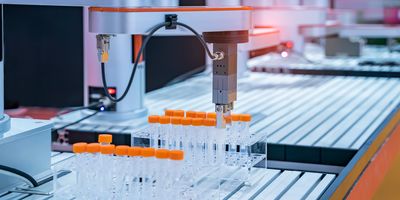Designing a Fully Autonomous Laboratory
Autonomous labs are designed, not organic, and require extensive hardware and software connectivity
Pascal Miéville has a PhD in hyperpolarized nuclear magnetic resonance with Prof. G. Bodenhausen at the École Polytechnique Fédérale de Lausanne (EPFL). In 2020, Pascal was appointed executive director of the Swiss CAT+ West Hub Swiss National Research Infrastructure.

Robert H. Williams has over 20 years of experience in the design of software solutions. Leveraging his background in analytical chemistry and instrument development, he has coordinated with end users to co-develop innovative products and solutions to increase laboratory efficiency and productivity.
Q: Tell us about the project, what you did, and why a collaboration was important.
PM: EPFL and Agilent are collaborating on EPFL’s “SwissCAT+” project. Our goal is to create an open-access, fully autonomous laboratory for the discovery, development, and optimization of sustainable catalytic processes while serving as a model for future autonomous laboratories.
A fully autonomous lab must be carefully planned and designed. Such a lab cannot be “organically” grown over time as all the hardware and software must work in concert. At present, we are developing the physical platform and identifying and developing all the automated equipment. We quickly realized it would be impossible to reach the level of automation we needed alone. We reached out to several vendors and Agilent was the most open for collaboration.
RW: The opportunity was well aligned with our initiative for digitizing the laboratory and working with an end user to ensure that our application programming interfaces (APIs) and other connectivity tools were up to the task. The project matched our desire to be open and facilitate connections between our hardware and software to those of a third party. It was well aligned with our overall laboratory optimization theme that extends to more traditional labs to automate data flows and reduce errors. Lastly, we saw an opportunity to develop some best practices in terms of developing software to facilitate connectivity.
Q: How are hardware and software interconnected, and how can they be integrated?
PM: Most laboratory equipment is designed to be used by humans. In an autonomous laboratory, the ergonomics of the hardware must be redesigned or modified to be used by laboratory robots and optimally interconnected. Current equipment designs are very linear in nature, where machines are installed on benches. Some elements, such as the Flex Bench system, give a certain degree of freedom for this linearity, but still not enough from our point of view (e.g., the equipment’s back and sides are inaccessible). A beehive design that supports cylindrical symmetry is ideal for robotic systems. The robot in the center serves a series of 6 to 8 stations on its periphery. It would be ideal for us to be able to organize the equipment as beehive clusters, served by only one robot and safely accessible by humans at the periphery. It is also important to mention that the operational continuity needs to be changed. Safety mechanisms on the devices need to be altered; for example, if you open the fraction collector on an autosampler while it’s running, the system stops. In an autonomous system, that can all be timed appropriately to enable that device to be opened during an analytical run.
RW: The challenge with optimizing the hardware and the software in autonomous solutions is the heterogeneity of the hardware and software required to build such a solution. From the robotics hardware and software to the analytical instrument hardware and software, including data management, one must employ a wide variety of solutions from different vendors. Not only must the analytical instrumentation hardware be automation-friendly, but the software must be flexible and have the appropriate APIs and adapters to connect to virtually any solution. We also need to ensure that the data (metadata or analytical data) is available in a vendor-neutral format to enable it to be passed from one application to another.
Q: What role does software play in the autonomous lab?
PM: Software aids in scheduling and managing all the hardware to ensure that samples flow through the lab efficiently from one station to the next. It also manages the data flow across the lab ensuring that the data and required metadata flow from one station to the next. Lastly, software is also critical for processing results, whether that is low-level data processing on the instruments themselves to the artificial intelligence/machine learning (AI/ML) algorithms that produce the scientific insights from the experiments.
Q: You said the software needed to be fully integrated. To achieve this, what is required of both the vendors and the consumers of the required software?
PM: As the consumer, we need to ensure we have the appropriate software developers and IT infrastructure to connect all these components, carefully articulating our requirements to the various vendors. In the event there is an overlap between the capabilities of the various software packages, we need to use those requirements to strategically choose what software packages to use when, and where. Different use cases will require different solutions so there is no single answer. This is why an autonomous lab needs to be carefully designed.
Q: You just mentioned laboratories must be designed again. Could you expand on what you mean there and why?
PM: Up until now, laboratories, even those with some automation, have grown organically. Because labs are traditionally built around the required chemistries, this approach was effective. In the future, I believe, laboratories are going to be designed around data and the flow of data. We are employing this very approach where fundamental design aspects will be dictated by the requirements for managing and using data.
RW: We are seeing this shift as well. More end users are making choices about instruments and software based on data management and interoperability and less so on performance characteristics. More end users are also employing AI/ML, which is driving them toward laboratory designs focused on data.
Q: You mentioned AI/ML. In the autonomous lab, where is AI/ML implemented, and where do you see it being used in the future?
PM: AI is currently employed in the lab to optimize synthesis. After collecting all the data about a particular set of reactions, we use AI/ML to identify better reaction conditions. We can also see AI/ML used to generate protocols, improve, or accelerate operational workflows, improve the scheduling of equipment, and improve method selection. The autonomous lab provides many opportunities for AI/ML to optimize laboratory utilization.
Q: What are the key takeaways, in your opinion, when it comes to developing an autonomous lab?
PM: Autonomous labs are designed, not organic, and are a developmental process involving a substantial transition surrounding software and hardware interconnectivity. For the best results, software and hardware must come from the same vendor. Lastly, protocols in place with modern hardware are designed to protect humans. A lot of this needs to be rethought for robots. Our work at EPFL with the SwissCAT+ project has this goal in mind, and we hope it serves as a useful model for the development of autonomous laboratories in the future.
To learn more about Agilent's Digital Lab Solutions, visit: https://www.agilent.com/about/digital-lab/en/
To talk to an expert who can help you take the next steps on your digital lab journey, visit: https://explore.agilent.com/digital-lab-contact-us or contact your local Agilent sales representative.
Sponsored by Agilent and Agilent OpenLab

